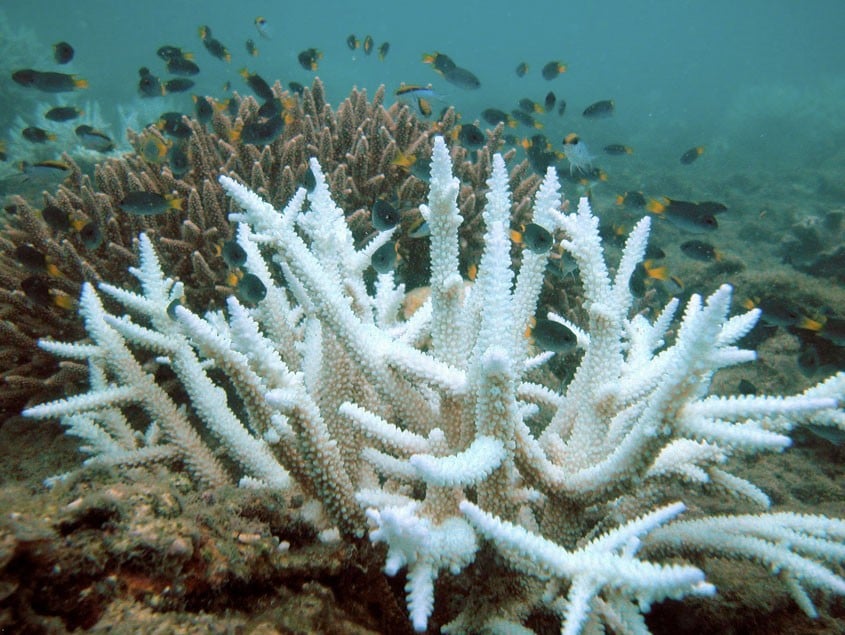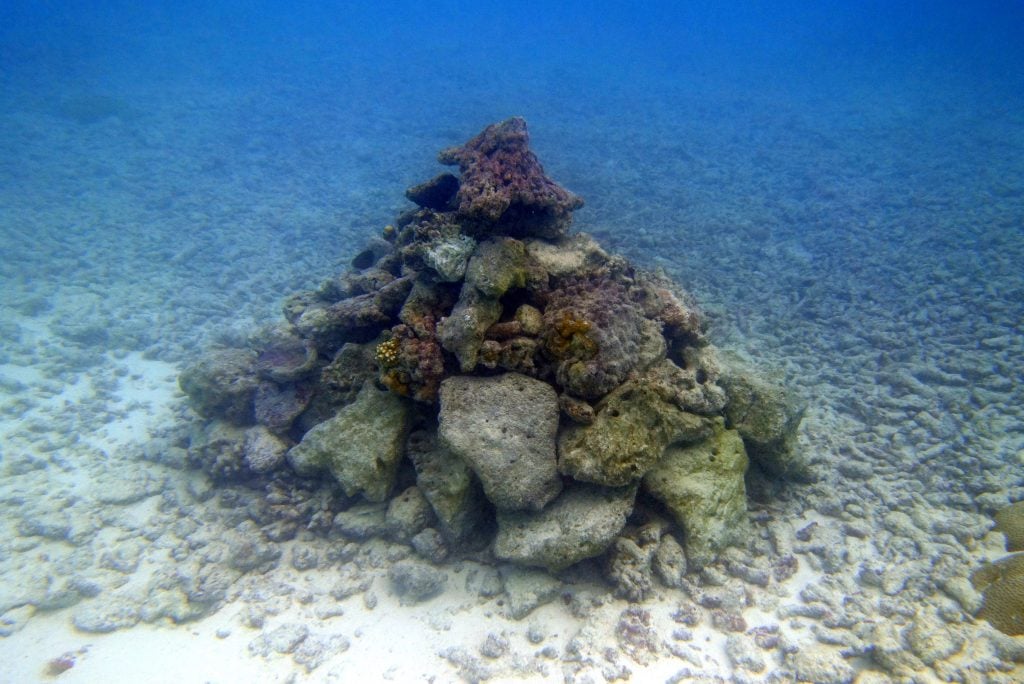Home to more than a quarter of all marine species, coral reefs are one of the most diverse ecosystems on the planet. But these reefs are now under threat.
Of the many problems facing coral reefs, rising sea temperatures due to global warming are perhaps the most serious. In 1998, a complex climate event in the Pacific Ocean known as ‘El Niño’ pushed global temperatures to new highs and killed 16% of coral worldwide; this was declared the first major global coral bleaching event. The El Niño of 2010 triggered the second global event, and in October 2015 The US National Oceanic & Atmospheric Administration (NOAA) announced a third global bleaching event – so far this has been the longest event recorded, impacting some reefs in successive years.

recently bleached coral
Here in the Maldives, we witnessed the effects of global warming first hand when the bleaching event caught up with us in 2016 – affecting about 60% of corals.
In view of the environmental and economic value of coral reefs there is considerable interest in preventing further damage as well as rehabilitating and/or restoring coral reefs subjected to damage. A widely adopted method for reef restoration is the construction of Artificial Reefs (AR’s). The main purpose of these structures is to attract fish by providing them with habitats that are as favourable as those that were present in the original environment.
Gili Lankanfushi is surrounded by a beautiful and diverse coral reef, but we weren’t exempt from the bleaching of 2016, and some of the varied habitats once provided by corals have disappeared. To aid the reef we recently constructed a small AR adjacent to the damaged coral. In this instance, the term ‘artificial reef’ is somewhat of a misnomer as its purpose is to rehabilitate an already existing reef; so a better way to think of our project is the building of ‘fish homes’. To maintain the natural aesthetic we are accustomed to here at Gili, the AR was constructed using natural rock from around the island. After settling on a location the rocks were assembled in a pyramid shape and care was taken to leave several openings as previous studies found that reef blocks which had a higher number of holes also possessed the greatest fish species richness and abundance. We have named our structure Mahuge Veshi (Pronunciation: ma-hoo-geh veh-she), meaning fish environment.

Mahuge Veshi
AR’s tend to develop in fairly predictable stages: When an ocean current encounters a vertical structure it creates a plankton-rich up-welling. This up-welling provides a reliable feeding spot for small fish, which draw in pelagic predators such as trevallies and sharks. Next come creatures seeking protection – hole and crevice dwellers such as grouper, snapper, squirrelfish, eels, and triggerfish. Over months and years the reef structure becomes encrusted with algae, tunicates, hard and soft corals, and sponges which add to the structural integrity of the AR. There is an expectation that ecologically the AR will resemble the local natural environment over the long term as plant and animal assemblages associate with the structure.
We know from previous studies that AR’s can increase the total aggregate of fish and invertebrate species, and in some cases the abundance of corals have exceeded that of adjacent natural reef areas.
The use of AR’s to increase fish populations goes back at least 400 years, but there have been suggestions that they don’t actually increase the total numbers of fish, and act simply as attractors; moving fish from one place to another. However, we know from well documented studies between animals and their environment that when a habitat range is extended their numbers tend go up.
Imagine an island populated with birds: their population is at its limit, until one day another island appears within flying distance. What we would expect to see is a sequence of events:
- Arrival – Some of the birds would migrate from the old island to the new one.
- Population increase – With more nesting space available the populations of each island would increase.
- Persistence – Assuming a steady supply of resources (food, nests, etc.) the birds on each island would thrive.
AR’s can be thought of like underwater islands, and for each one built we essentially extend the geographical range of the animals that live within reef structures, and so we would expect to see the same sequence of events mentioned above.
So far Mahuge Veshi has been visited by large schools of surgeonfish, butterflyfish, and on last inspection a large moray eel had made itself at home within the structure. The Mahuge Veshi project is a simple, environmentally friendly and self-sustaining venture. All being well, the structure will help grow the natural area and support help marine life while our corals recover.